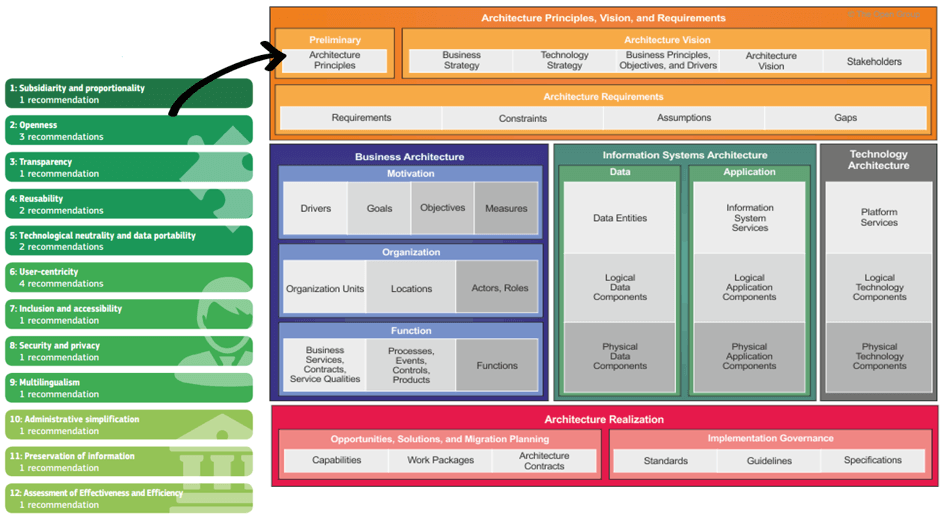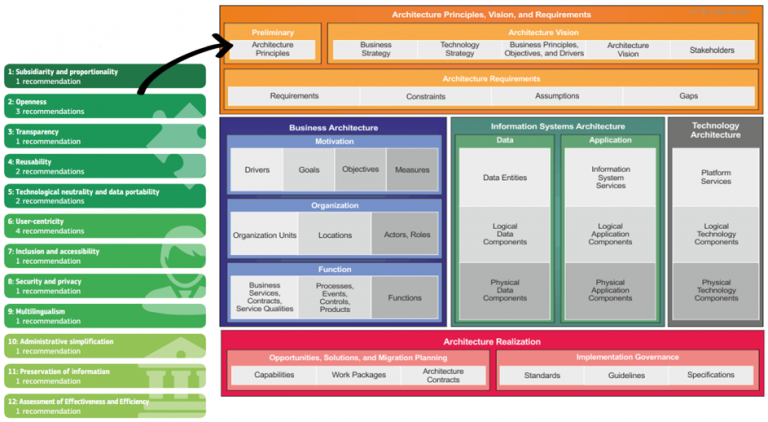EIF interoperability principles

Download the full article here
Principles describe basic approaches and means that must be pursued to achieve a business goal. The Principles are general rules and guidelines that are permanent and rarely changed. They inform and support the way an organization fulfills its mission. These principles provide an agreed reference framework for evaluating alternatives and decisions. Corporate principles provide a basis for decision-making throughout the organization and how the organization accomplishes its mission. Architectural principles are a set of principles that relate to architecture and usually derive from corporate principles. Normally, principles are developed for each architecture domain, e.g. Business principles, data principles, application principles, etc., and so interoperability principles. EIF offers 12 principles that can be reused in projects, accelerating architectural development work and ease the life’s of architects.
The term interoperability principle refers to fundamental aspects of behavior that must be considered in interoperability programs. Principles are requirements for requirements. Principles set out general interoperability norms that are relevant to the process of building interoperable European public services. They describe the context for the design and implementation of European public services. The twelve principles of the EIF can be divided into four categories and can be reused, for example, in a TOGAF-driven architectural development:
- The principle that defines the context for EU action on interoperability (No 1)
- Key Interoperability Principles (No 2 to 5)
- Principles relating to general user needs and expectations (No 6 to 9)
- Principles for cooperation between public administrations (No 10 to 12)

EIF proposes the following principles:
1. Subsidiarity and proportionality
The principle of subsidiarity states that EU decisions must be taken as closely as possible to the citizens. This means that the EU can only act if it is more effective than if the same measures were taken at national level. The principle of proportionality limits EU intervention to the extent necessary to achieve the policy objectives set out in the Treaties.
With regard to interoperability, an EU-wide framework is justified in order to overcome policy differences resulting in inhomogeneity and insufficient interoperability, thereby jeopardizing the Digital Single Market.
The EIF is intended to serve as a “common denominator” of the different interoperability strategies of the Member States. Member States should have sufficient leeway in the preparation of their NIF with regard to the recommendations set out in the EIF. The NIFs shall be trimmed and extended in such a way that it adequately considers national specificities.
2. Openness
In the context of interoperable public services, the concept of openness refers primarily to data, specifications and software.
Open government data (hereinafter referred to simply as open data) refers to the concept that all public data should be freely available for use and re-use by others, insofar as they do not impose restrictions, for example, on the personal data, confidentiality or intellectual property rights. Public administrations collect and generate huge amounts of data. The Public Sector Information Re-Use Directive (PSI) encourages Member States to make public information available for access and re-use as open data. The INSPIRE-Directive also requires the exchange of spatial data sets and services between authorities without restrictions and practical obstacles to their re-use. The data should be published with as few restrictions as possible and with clear licenses for their use, in order to allow better scrutiny of the administrative decision-making processes and to achieve transparency in practice.
The use of open source software technologies and products can help to save development costs, avoid a lock-in effect and enable rapid adaptation to specific business needs, because the Developer communities that support such technologies and products are constantly adapting them. Public administrations should not confine themselves to using open source software but should also contribute to the relevant developer communities where possible. Open source is a key requirement of the EIF-principle of reusability.
The level of openness of a specification/standard is critical for the re-use of software components used to implement this specification. This also applies to the use of such components in the introduction of new European public services. When the principle of openness is fully met:
- all stakeholders have the opportunity to participate in the development of the specification and a public review is part of the decision-making process
- the specification is available to anyone for inspection
- the licensing of intellectual property rights in the FRAND Terms Specification is carried out in a manner that allows integration into both proprietary and open source software, preferably in a free-of-charge form.
The use of such open specifications is advocated in many policy statements because of its positive effect on interoperability and is recommended for the provision of European public services. The positive impact of open specifications is illustrated by the ecosystem of the Internet. However, public administrations may opt for the use of less open specifications unless open or functional requirements are present. However, apart from their application to create innovative solutions, the specifications should in any event be mature and sufficiently supported by the market.
Finally, openness also means empowering citizens and businesses to participate in the design of new services, to contribute to the improvement of services and to express their views on the quality of public services provided.
3. Transparency
Transparency in the EIF context means:
- Ensure visibility in the administrative environment of a public administration. The aim is to give other public administrations, citizens and businesses an insight into and understand the rules, processes, data, services and decision-making processes of the administration.
- Ensure the availability of interfaces to internal information systems. Public administrations often operate a variety of different information systems to manage their internal operations. Interoperability must ensure that interfaces are available to these systems and to the data they process. In turn, interoperability facilitates the re-use of systems and data and enables their integration into larger systems.
- Ensuring the right to the protection of personal data by complying with the applicable legal framework for the large amounts of personal data held and managed by citizens held by public administrations.
4. Reusability
Reuse means that public administrations facing a particular problem should try to make use of the work of others by seeking existing solutions, examining their usefulness and usefulness, and where appropriate, solutions that have already proven themselves elsewhere. This presupposes that public administrations are prepared to share their interoperability solutions, concepts, frameworks, specifications, instruments and components with others.
The reusability of IT solutions (e.g. software components, application programming interfaces, standards), information and data are a prerequisite for interoperability and ensures their extended operational use Quality improvements. It saves time and money. In doing so, it is making a significant contribution to the development of a digital single market in the EU. Various EU standards and specifications are also reflected in the DIF and should be applied more widely. For example, the INSPIRE Directive sets out interoperability standards in relation to addresses, cadastral data, roads and a wide range of other data-related issues that are relevant to many public administrations. These existing standards and specifications can and should be used beyond the area for which they were originally developed.
Various public administrations and governments are already promoting the sharing and re-use of IT solutions through the introduction of new business models and advocating the use of open source software for central ICT services infrastructures for digital services.
A number of key challenges stand in the way of greater sharing and re-use of IT solutions at the technical, organizational, legal and communicative levels. The ISA2 framework for sharing and re-using IT solutions provides recommendations for public administrations to help them address these challenges and share common IT solutions exchange and re-use. The re-use and sharing can be effectively supported by means of cooperation platforms.
5. Technological neutrality and data portability
When setting up European public services, public administrations should focus on their functional requirements and postpone decisions on the underlying technology for as long as possible so that they can be used by those who use such services. not to impose certain technical implementations or products in the first place and are later able to adapt to a rapidly changing technological environment.
Public administrations are called upon to ensure access across technology and products and to make the same reusability of the services and data they provide.
The functioning of the Digital Single Market requires that data can be easily exchanged between different systems in order to avoid a lock-in effect and to support the free movement of data. This requirement relates to data portability—the ability to easily move and reuse data across applications and systems, which is an even greater challenge in cross-border scenarios.
6. User-Centricity
The term user of European public services refers to any public administration, citizen and company that accesses and benefits from these services. User needs must be considered when determining which public services should be provided and how this should be done.
Therefore, the design and development of public services should be guided to the greatest extent possible by user-side needs and requirements:
- A concept of multi-access service provision, i.e. the availability of alternative channels, both physical and digital, is an important part of the design of public services, as users are informed of circumstances and needs may prefer different access routes
- Users should be provided with a one-stop shop to both mask the internal complexity of administration and facilitate access to public services, e.g. when multiple bodies providing a public service need to work together
- User feedback must be systematically recorded, evaluated and used in the creation of new public services as well as to improve existing ones
- To the fullest extent possible, under the applicable legislation, users should be able to transmit data only once, and administrations should be able to access their data in accordance with data protection rules for the benefit of the user and Exchange
- Users should be encouraged to provide only the information strictly necessary to use a particular public service.
7. Inclusion and accessibility
Inclusion is about giving everyone the opportunity to make full use of the opportunities offered by new technologies to access and use European public services, thereby creating social and economic divides and an existing to overcome exclusion.
Accessibility will ensure that people with disabilities, the elderly and other disadvantaged groups can access public services in a quality that can be compared to the other citizens.
Inclusion and accessibility aspects must be considered throughout the life cycle of a European public service in design, information content and delivery. The latter should comply with the widely accepted requirements at European and international level for barrier-free access for all citizens at European and international level.
Inclusion and accessibility usually mean that services are provided via several access channels. In addition to electronic provisioning, a traditional paper-based or personal-language offer may be required.
Inclusion and accessibility can also be improved through a system that allows third parties to act on behalf of citizens who are themselves temporarily or permanently unable to access public services directly.
8. Security and privacy
Citizens, like businesses, must be able to trust that their contacts with authorities take place in a secure and trustworthy environment in which the relevant rules, such as the Directive and the Regulation on Data Protection, or the Regulation through electronic identification and trust services. Public administrations must guarantee the privacy and confidentiality, authenticity, integrity and non-remunerability of the data provided by citizens and businesses.
9. Multilingualism
European public services can in principle be used by anyone in any Member State. In its design, therefore, due account must be taken of multilingualism. Citizens across Europe often have problems accessing and using digital public services when they are not available in the language they speak.
It is therefore necessary to strike a balance between the expectation of citizens and businesses to be served in their own language or the language(s) they prefer and the ability of the public administrations of a Member State to provide their services in all official EU languages. Such a balance could be that European public services are offered in the languages of the expected end-users, i.e. the definition of the number of languages offered is based on user-side needs; for example, the degree to which the service is relevant to the implementation of the Digital Single Market or national policies, or the size of the audience concerned.
The aspects of multilingualism are important not only for the user interface, but at all levels of European public services. For example, the chosen form of displaying data in an electronic database should not limit the possibility of supporting different languages.
The aspect of multilingualism is also of particular importance for interoperability where a public service requires the exchange of data between information systems across language boundaries, because the importance of the exchanged information must be preserved.
10. Administrative simplification
By improving or eliminating all that is of no use to the public, public administrations should streamline and simplify their administrative procedures as much as possible. Administrative simplification can help businesses and citizens reduce the administrative burden of complying with EU rules or national obligations. Similarly, public administrations should introduce European public services based, inter alia, on electronic means in their interactions with other public administrations, citizens and businesses.
The digitization of public services should be in line with the following concepts:
- ‘by default, digital’ where appropriate, so that at least one digital channel is available for access to and use of a European public service
- ‘primarily digital’, which means that when applying the concept of multi-access channel deployment and a system where there is no wrong point of contact (because operations are always internally forwarded to the competent authority), i.e. physical and digital channels coexist, and the use of public services via digital channels must be given priority.
11. Preservation of information
Decisions and data must be stored and held available for a certain period of time in accordance with the legal requirements. This means that records and information in electronic form held for the purpose of documenting procedures and decisions of public administrations are retained and, in the event that the storage media used so far should be outdated, must be transferred to new media. The aim is to ensure that records and other forms of information maintain their readability, reliability and integrity and remain accessible as long as necessary in accordance with security and data protection regulations.
In order to guarantee the long-term preservation of electronic records and other types of information, it is necessary to choose formats that ensure long-term accessibility, including the preservation of related electronic signatures or seals. Ensure. In this respect, the use of qualified conservation services in accordance with Regulation (EU) No 910/2014 can ensure the long-term preservation of information.
This is a purely national matter for sources of information owned and controlled by national administrations. In the case of information that is not purely national, retention becomes a European matter. In such a case, in view of the possible difficulties arising from the use of the information in question in different jurisdictions, an appropriate retention policy should be applied by the Member States concerned.
12. Assessment of effectiveness and efficiency
There are many ways to assess the benefits of interoperable public services, such as profitability, total cost of ownership, flexibility and adaptability, reduced administrative burdens, efficiency, reduced risk, Transparency, simplification, improved working methods and the level of user satisfaction.
Various technical solutions should be examined in order to ensure the effectiveness and efficiency of a European public service.
Based on these principles, the EIF offers public administrations 47 concrete recommendations to improve the governance of their interoperability activities, to build inter-organizational relationships, to Streamlining processes to support end-to-end digital services and ensure that existing and new legislation does not affect interoperability efforts.
In the next blog the 4 views from EIRA will be discussed.






1 Comment.
[…] the previous part of this blog series the 12 interoperability principles of the EIF Framework were explained, in this […]